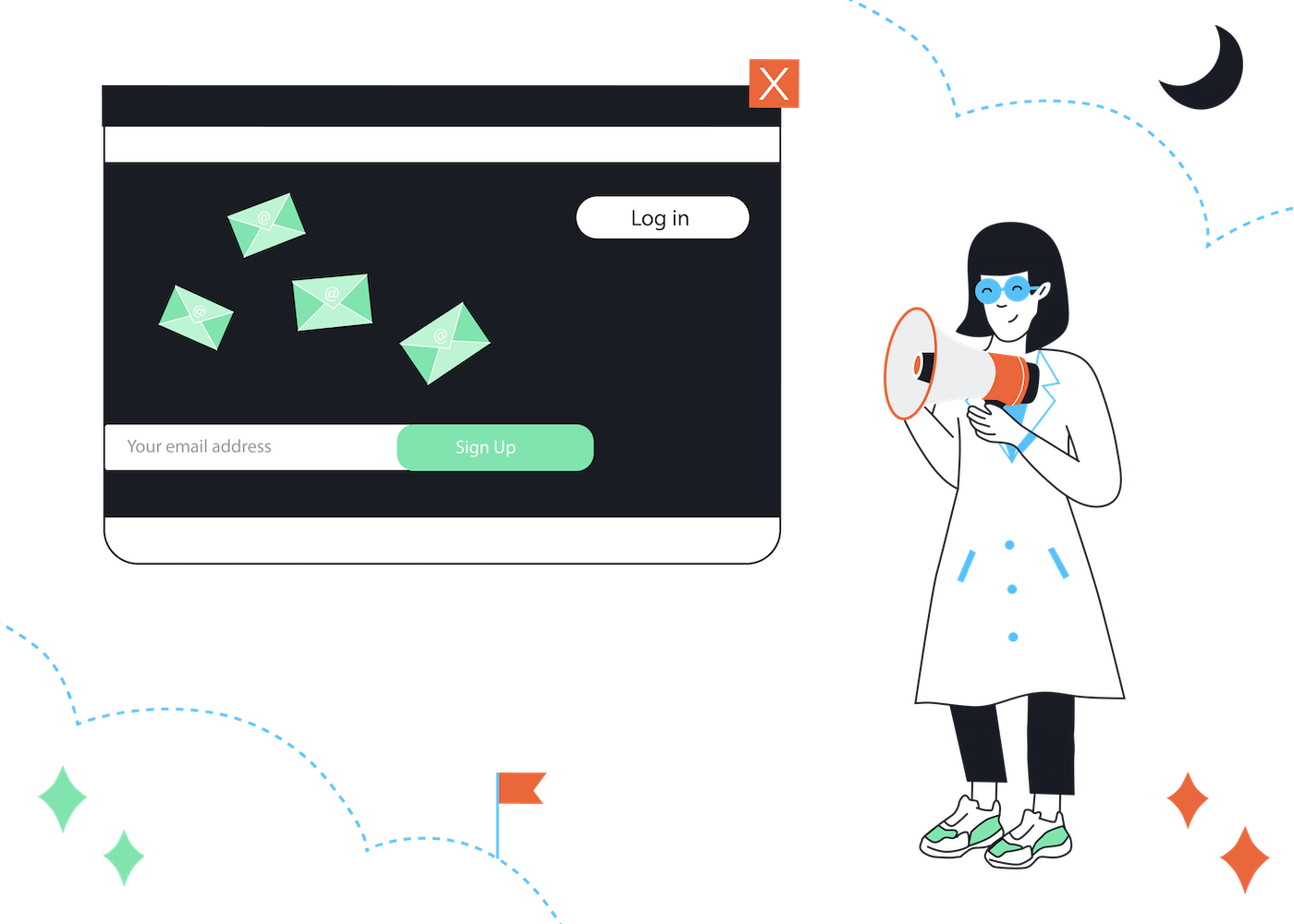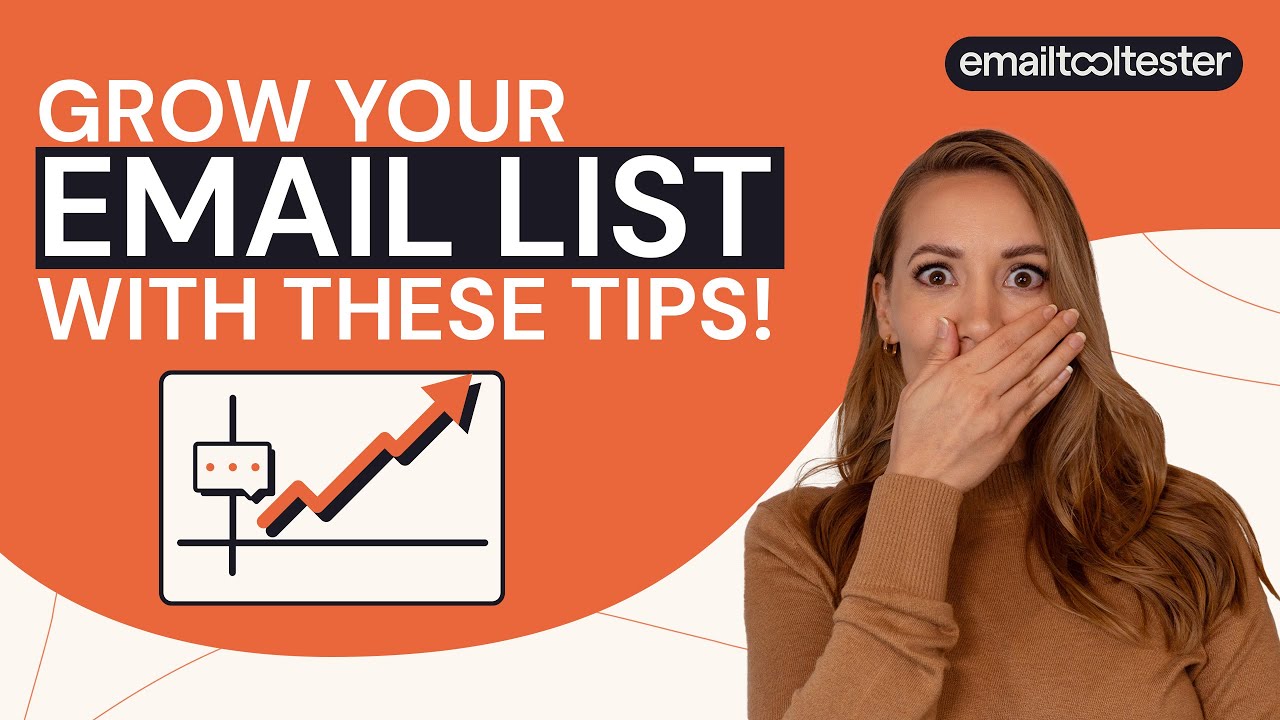Email list management can be a nightmare…
The money spent offering freebies (lead magnets) in exchange for email addresses. The hours creating segmentations and tags. The struggle to create copy that will engage subscribers.
And, despite all your effort, not enough subscribers are opening your emails or clicking on links. And that’s for the emails that get delivered to their inbox! On top of that, you also get unsubscribes and even some “report as spam.”
All of it is enough to make you want to give up on email marketing. I understand! As an email marketing specialist, I’ve been there. But, don’t worry!
In this article, I’ll share everything you need to know about email list management. You’ll learn the best tips, strategies and practices for maintaining a clean and healthy email list to achieve your email marketing goals.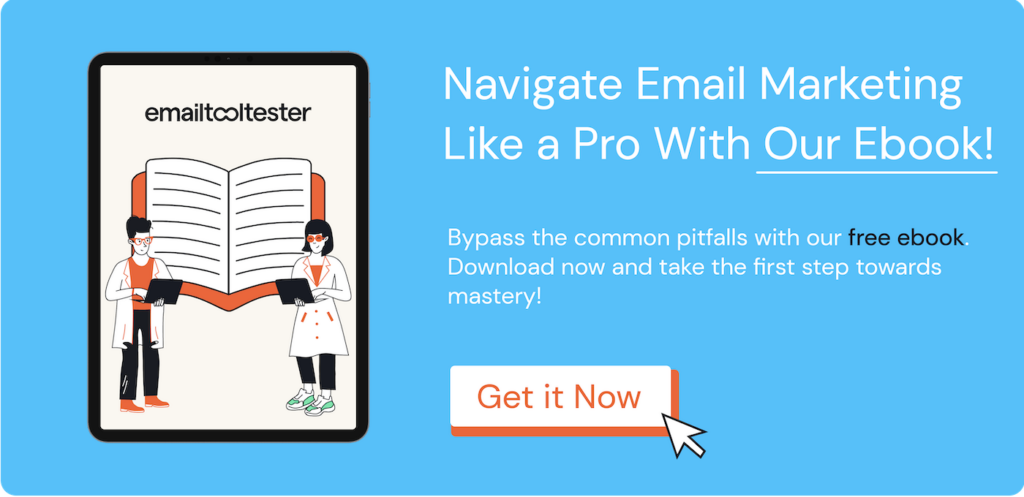
Continue reading to learn:
What is Email List Management?
Email list management is the process of managing a list, just as the name implies! Most people think that only means capturing subscribers, segmenting them into groups and sending emails to convert them.
But, managing an email list effectively entails more.
Email list management also includes things like: removing subscribers from your list, maintaining visible unsubscribe buttons and running re-engagement campaigns to delete inactive contacts.
Ultimately, email list management is the maintenance of a clean and healthy list to get higher engagement rates and better ROI (and stay in the good graces of your email service provider).
Why is Email List Management Important?
Do you want to avoid spam and land in your subscriber’s inbox? And have them open and engage with your emails? Then, you need to make email list management a priority.
Email list management is essential for the success of your email marketing campaigns. It ensures that you send emails only to people interested in your business and who are more likely to engage and convert.
These subscribers will open, read and click the links in your emails. So, you’ll have a high open and engagement rate. And, when they are engaged, you’ll have better deliverability, which means your emails won’t land in the spam box.
Additionally, it helps reduce your email marketing cost. By managing your list effectively, you won’t have to pay for unengaged subscribers who don’t add value to your business.
Email list management also helps keep your list healthy. And a healthy email list equals fewer unsubscribes, as subscribers are engaged. So, they'll be less likely to unsubscribe or report your email as spam, which can lead to poor deliverability and blacklisting.
What Makes A Healthy Email List?
A healthy email list is a list with healthy subscribers. No, I’m not talking about your subscribers’ BMI (although having a normal BMI is great). I mean subscribers with healthy email behaviors.
You know: behaviors like opening and reading your emails (not swiping to mark as read), clicking on links to check out your offers, responding to your emails to make inquiries, and even forwarding your emails to colleagues and friends.
So, to put it less dramatically, a healthy email list is a list with engaged subscribers. That is an email list with high open, click-through and conversion rates.
However, this doesn’t necessarily mean every subscriber on your list must be engaged. Based on Campaign Monitor’s 2022 Email Marketing Benchmarks Report, an open rate of 17-28% and a 2-5% click-through rate is good enough.
How To Maintain A Healthy Email List?
Maintaining a healthy email list must be a part of your email marketing strategy. Here’s a quick summary of how to do it:
- Verify email addresses with double opt-ins to improve deliverability
- Segment your subscribers to improve open and engagement rates
- Run re-engagement campaigns to remove inactive subscribers
- Clean your list to delete invalid emails that may cause hard bounces
- Remove duplicate emails that may cause confusion or skew metrics
Now let’s delve into these points in a bit more detail. Continue reading to learn the best email list management practices to maintain a healthy list.
Email List Management Best Practices
1. Get permission
Your subscribers’ email address is their private online mailbox. So, you shouldn’t invade their privacy by sending them emails without permission.
Just because they gave you their email address in exchange for a freebie or discount, it doesn’t mean you’re permitted to add them to your email marketing list.
Getting permission and consent from subscribers is the first step for effective email list management.
Why?
Well, people don’t like getting unsolicited emails and will unsubscribe from emails they didn’t consent to receive. Worse, some people may report your email as spam.
Consequently, this will tank your deliverability rate. You may even get banned if enough people report your emails as spam.
Furthermore, GDPR and CAN-SPAM rules require you to get consent from people before adding them to your list, or you risk getting fined heavily. The GDPR is the data regulation law for the European Union, and its equivalent in the U.S. is the CAN-SPAM Act.
So, how do you get permission to email subscribers?
You do so by adding a consent button to all your sign up forms. Yes, even if you’re offering a lead magnet or freebie.
The best online form builders allow you to add a check field and a consent clause to your opt-in forms. So, when subscribers click the check field, they permit you to add them to your email.
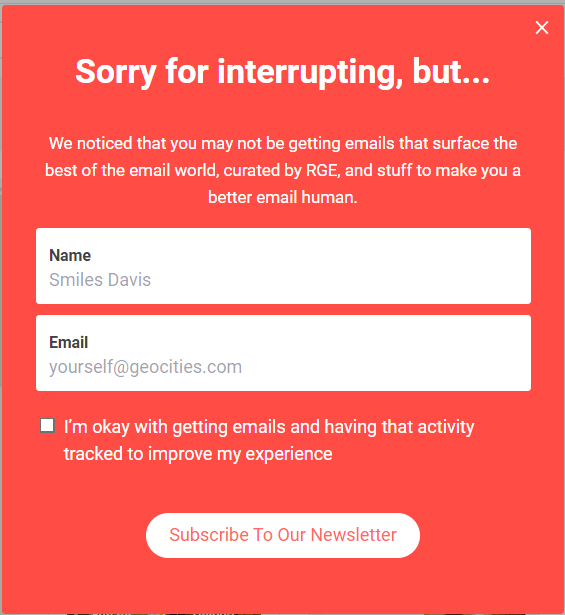
Image Credit: Really Good Emails
2. Use double opt-in
When someone submits their details to subscribe to your list, that’s a single opt-in. On the other hand, a double opt-in involves an extra step to gain explicit permission to add them to your email marketing list.
Here’s how using a double opt-in works:
After subscribing to your list, the subscriber would receive an email asking them to confirm that they really want to be on your list by clicking a confirm subscription button (see the example below).
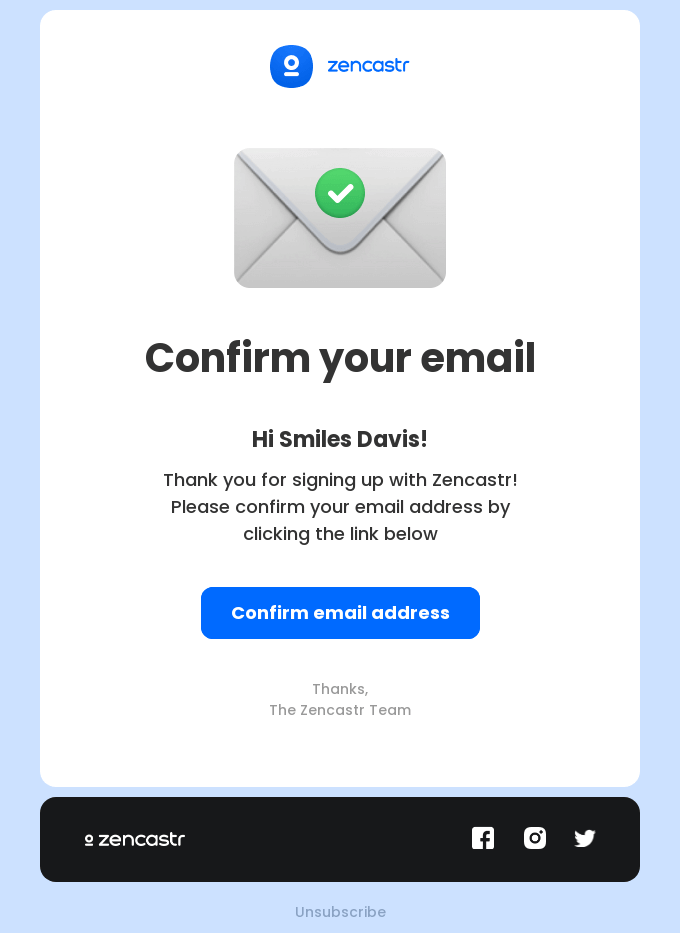
Image Credit: Really Good Emails
Shouldn’t the consent box suffice? In theory, it should.
And, to be honest, there’s a risk of losing subscribers who won’t confirm their subscription when you use a double opt-in.
However, people often submit invalid or inactive email addresses, especially if you’re offering a freebie. So, double opt-in helps you verify that their email address is active and accessible.
Hence, even though you might lose some subscribers, the double opt-in is a great email list management practice that ensures you only have quality subscribers interested in hearing from you.
Additionally, double opt-in is legally required in some EU countries, such as Austria, Germany, and Switzerland. Although it isn’t an explicit requirement in the GDPR rules, it’s always a good idea to use double opt-in.
3. Make new subscribers feel welcome
Offering a gift, such as a discount or a freebie, is one of the best ways to attract new subscribers to join your list.
However, don’t just send a single email delivering the gift and thanking them for joining your list. And then, disappear until your next sales campaign or newsletter.
You have to make new subscribers feel welcome by creating a welcome email series that provides value to new subscribers (aka., throw an email welcome party). This will get them hooked, and looking forward to your subsequent emails.
Moreover, because welcome emails are sent right after a subscriber joins your list, the open rate is 4x that of a regular email. So, it’s a good time to make an excellent first impression.
Ensure that the email is relevant and devoid of spam trigger words. Remember that high-quality content is one of the best practices for effective email deliverability.
(Last year, I got hooked reading Rob Allen’s emails after subscribing to his list. He gamified his welcome email sequence to get max engagement. I went down a rabbit hole reading 8 emails in one day because of how ridiculously engaging they were).
Lastly, share links to your social media profile where new subscribers can engage with you. You can do this subtly by adding linked social icons at the bottom of the email.
Here are some tips for creating a welcome series with a high engagement rate
- Personalize your emails
“Hi {first_name}” is a good starting point for personalizing your emails. You can also use your subscriber’s name in the subject line and the body copy.
However, email personalization goes beyond using your subscriber’s name…
Personalization involves connecting with your subscribers’ pain points. This means creating relatable and engaging email content that makes them feel like you understand their unique needs.
- Gamify your email CTA
Gamifying your email CTA involves offering gifts to subscribers in exchange for taking action. This entices subscribers to engage with your emails and increases your click-through rate.
For instance, in Rob Allen’s King of Conversion welcome email, he set up a “clicking test” and offered gifts and bonuses for every link clicked.
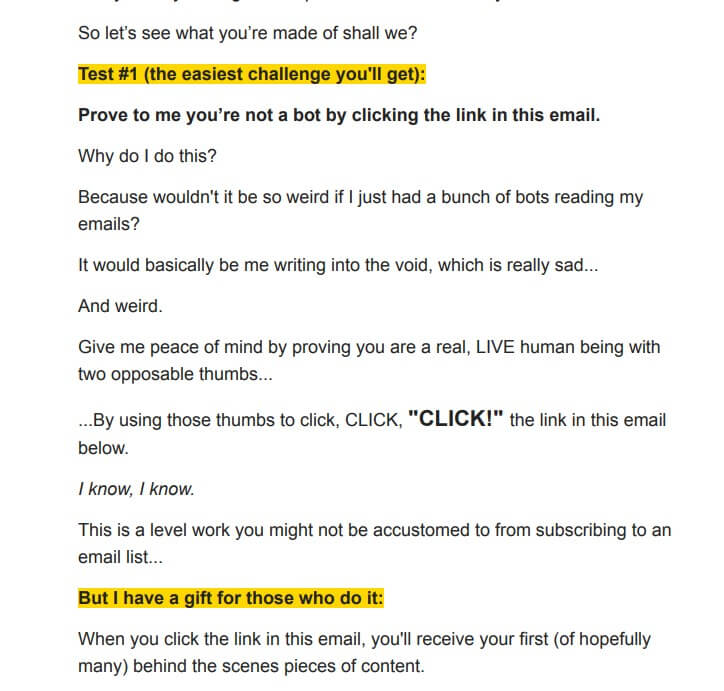
Also, even if subscribers join your email list via a freebie, you can still offer them an extra gift.
For instance, if they joined to get a 10% discount code, you can throw in a free delivery if they make their first order by a certain date.
- Ask them to whitelist your email
In your first welcome email, ask subscribers to add you to their contact list whitelist. This will help prevent your subsequent emails from landing in their spam box and increase your deliverability rate.
- Let them know your emailing frequency
Tell new subscribers how often they will receive emails from you and the type of content. Will they receive an email once weekly or every day? What will the email help them achieve, or what problem will it help them overcome?
- Ask them how you can help them
Whether you’re a service provider or you sell products, ask subscribers how you can help. Or, better still, include a section at the bottom of the email listing the different ways you can help.
4. Let contacts manage their subscriptions
Just because they signed up to your list doesn’t mean they want to hear from you daily. So, you should enable subscribers to choose how often and the types of email they want to receive from you.
You can include a subscription preference list on the opt-in form. For instance, you can add several subscription preference checkboxes, rather than a single consent box (see example below).
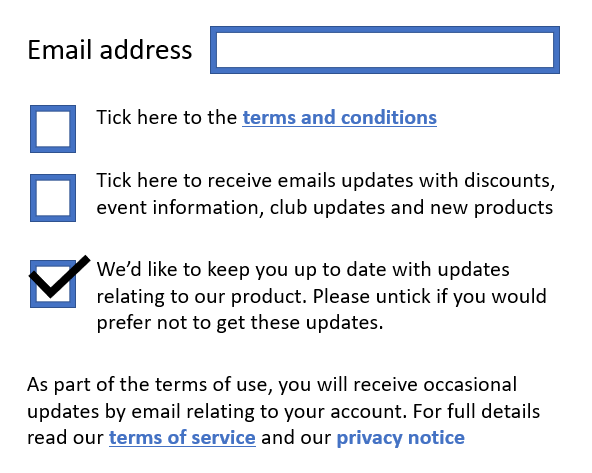
Image Credit: SAP Community
5. Make it easy to unsubscribe
Confession: I’ve reported an email as spam because I got frustrated looking for the unsubscribe button, and I’m certain there are many like me. As an email marketer, you should do everything in your power to stop your readers from doing the same!
To avoid getting reported as spam, make it easy to unsubscribe. Don’t hide the button, or make it un-clickable, or continue to email them after they finally find a way to unsubscribe from your list.
Not everyone will want to stay on your email list forever.
In fact, some people will even hit the unsubscribe button after they get access to your freebie. Or, a competitor may subscribe to peek behind your opt-in form (who else is guilty of this? I plead the fifth).
And that’s okay. Better they unsubscribe than remain on your list without opening your emails or engaging with them. They’ll eventually become inactive subscribers and hurt your list health.
Besides affecting your open and deliverability rate, you may get into trouble with the law. Making unsubscribe easy is an email list management practice required by the CAN-SPAM Act.
So, ensure that the unsubscribe button is easy to find on desktop and mobile. Some emails are so long that the unsubscribe button at the bottom gets cut off on mobile.
In addition to adding the unsubscribe button to the bottom of the email, you can add list-unsubscribe to your header. Then, the button will show up at the top of the email on desktop, or in the email options on mobile.
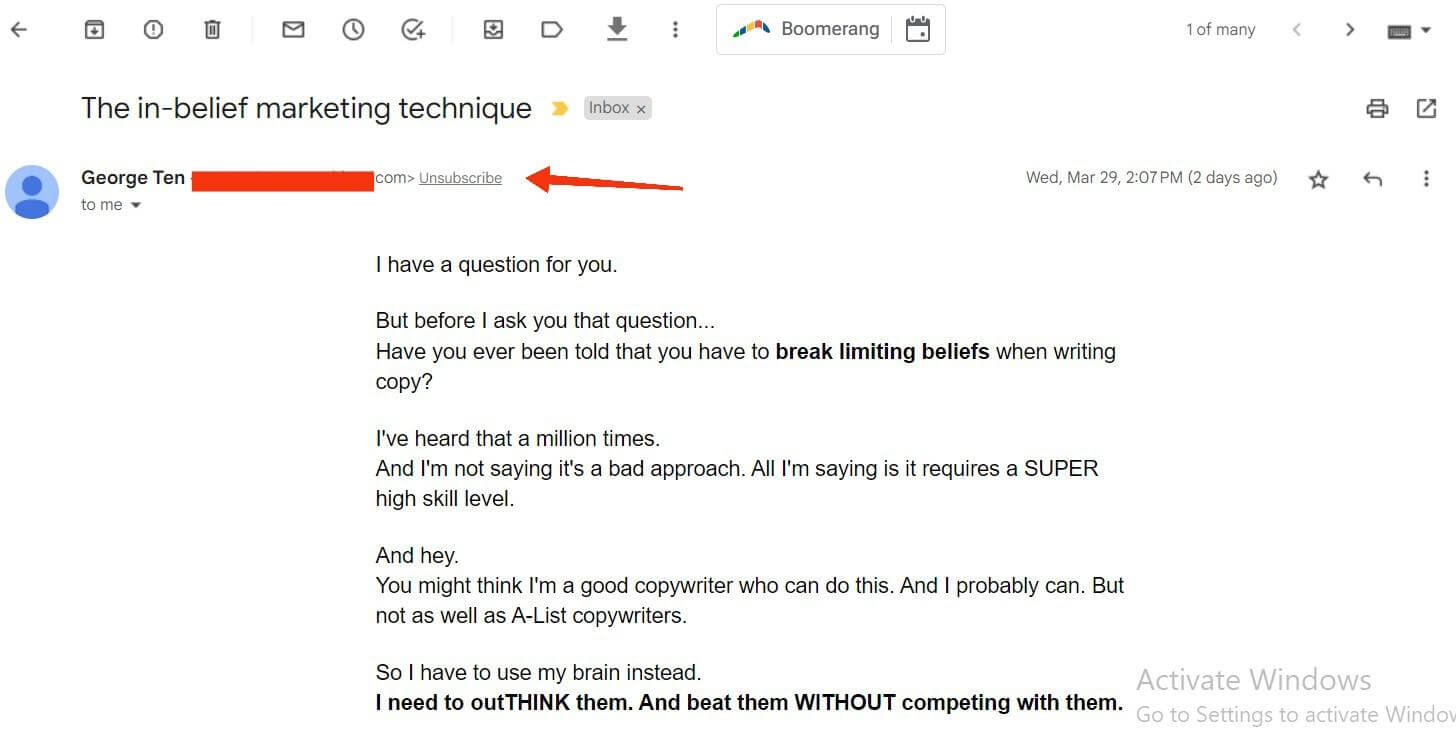
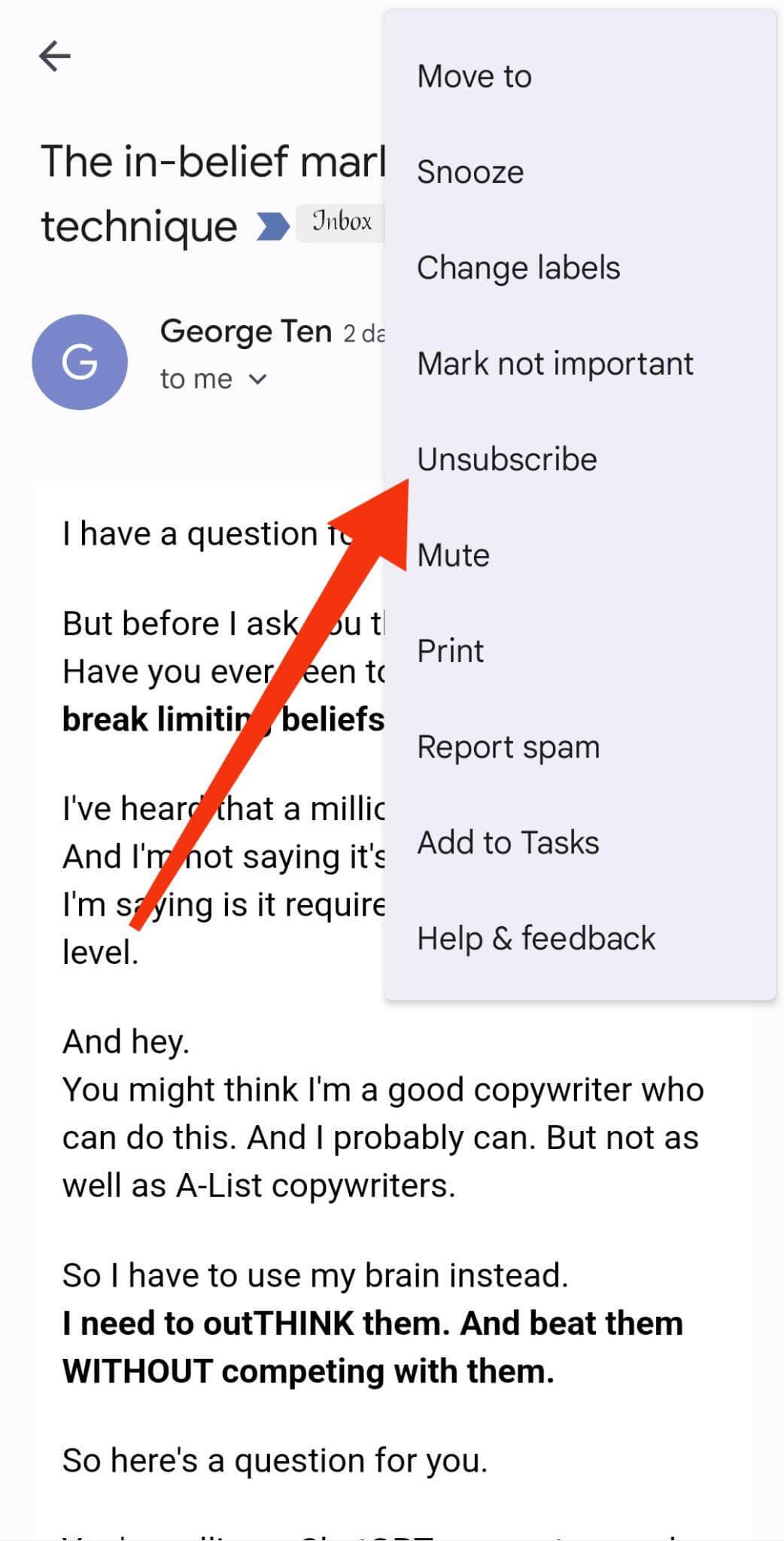
You could also add a snooze button to your emails. So, rather than unsubscribe, subscribers can snooze your email to take a break from getting your emails for a period.
Furthermore, you can add subscription preference center to your unsubscribe page, to reduce the number of unsubscribers. Many contacts will change their mind about subscribing and select a reduced email frequency instead.
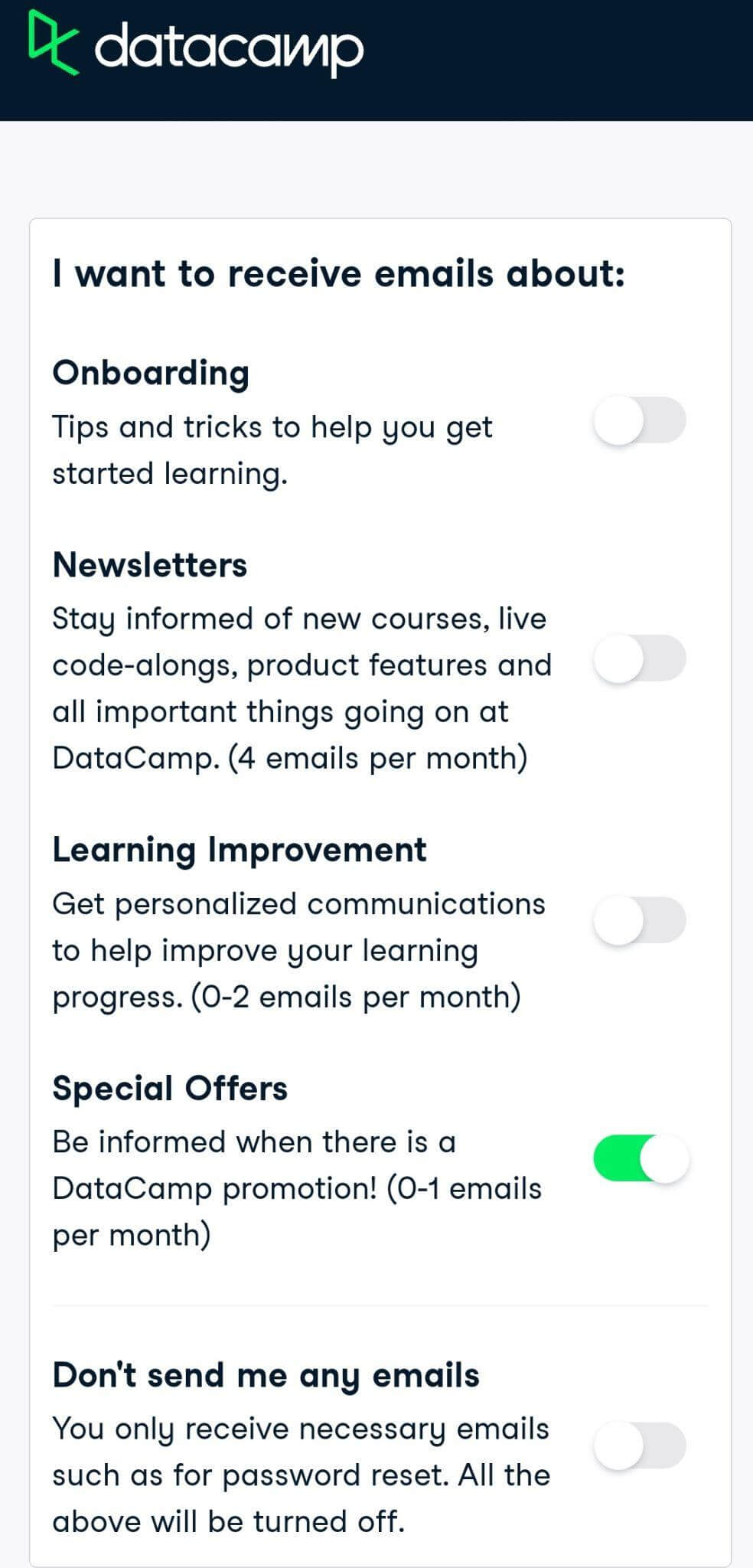
6. Segment your list
Segmentation is a popular email list management best practice. It involves categorizing your subscribers into groups with similar interests or characteristics to send them highly-targeted and personalized emails.
It sounds like a lot of work, but you don’t have to do it manually. That would take too much effort and time, even with a small list.
Most ESPs (email service providers), have segmentation features that allow you to categorize subscribers into different groups automatically.
Furthermore, you can set up automation rules for drip campaigns to send an email sequence to subscribers in different segments.
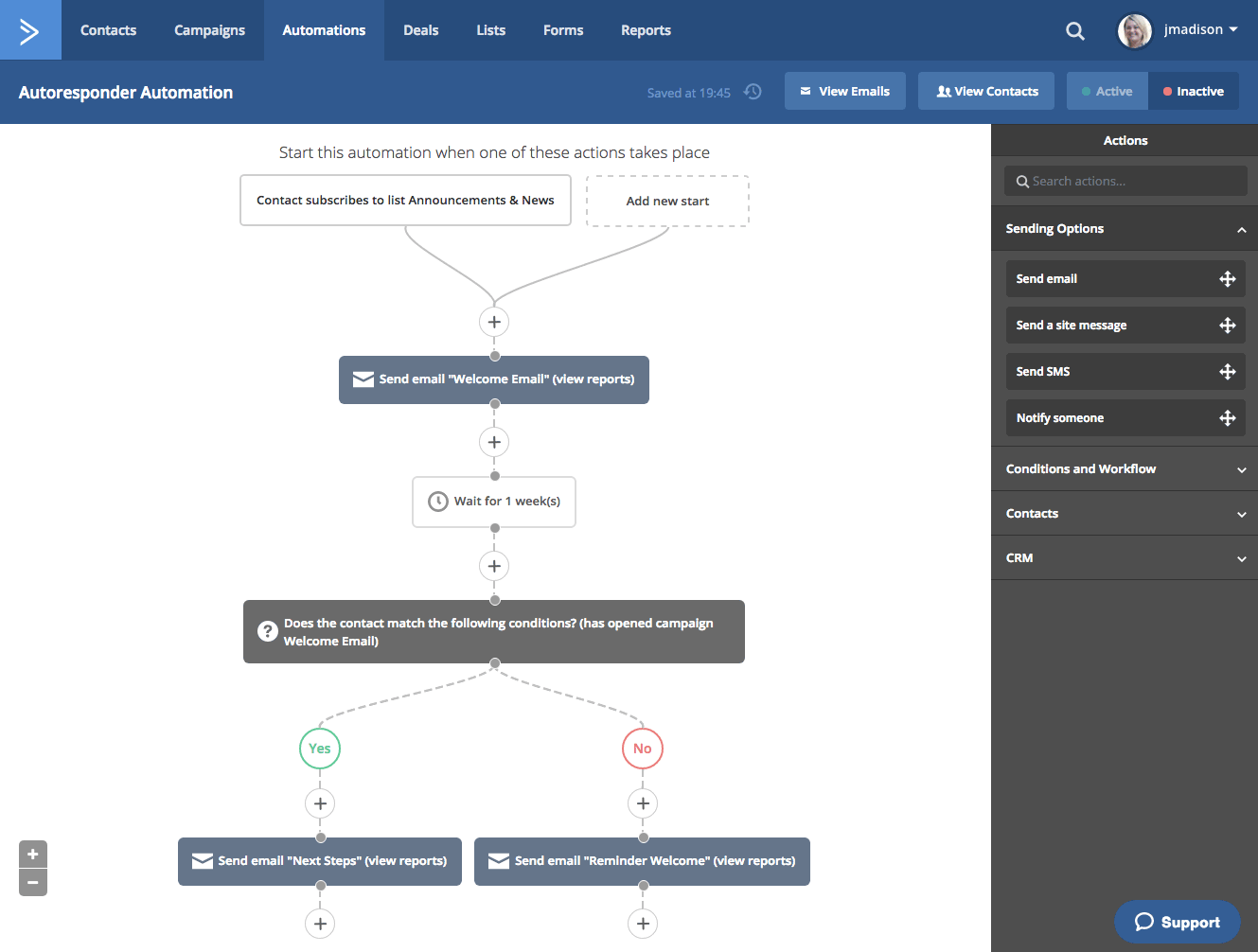
Image Credit: ActiveCampaign
Here are different ways you can segment your email list:
Demographic email segmentation
The simplest way to segment your list is by demographic characteristics. With this, you can send targeted emails to each subscriber based on their age, gender, education level, or location.
Say you own an ecommerce store that sells clothing items for all genders. Segmenting the list by gender will enable you to automatically send women’s clothing marketing campaigns to only female (or those who identify as female) subscribers. And vice versa for men too.
The same applies to location. For instance, if you’re a coach hosting an in-person event in Los Angeles, you could send the event invite to only subscribers residing in Los Angeles, rather than the entire list.
Behavioral segmentation
Have you ever received an abandoned cart email reminding you to complete your order? Something like this email below, which I received when I didn’t complete my order for a training course. That email was sent based on my behavior.
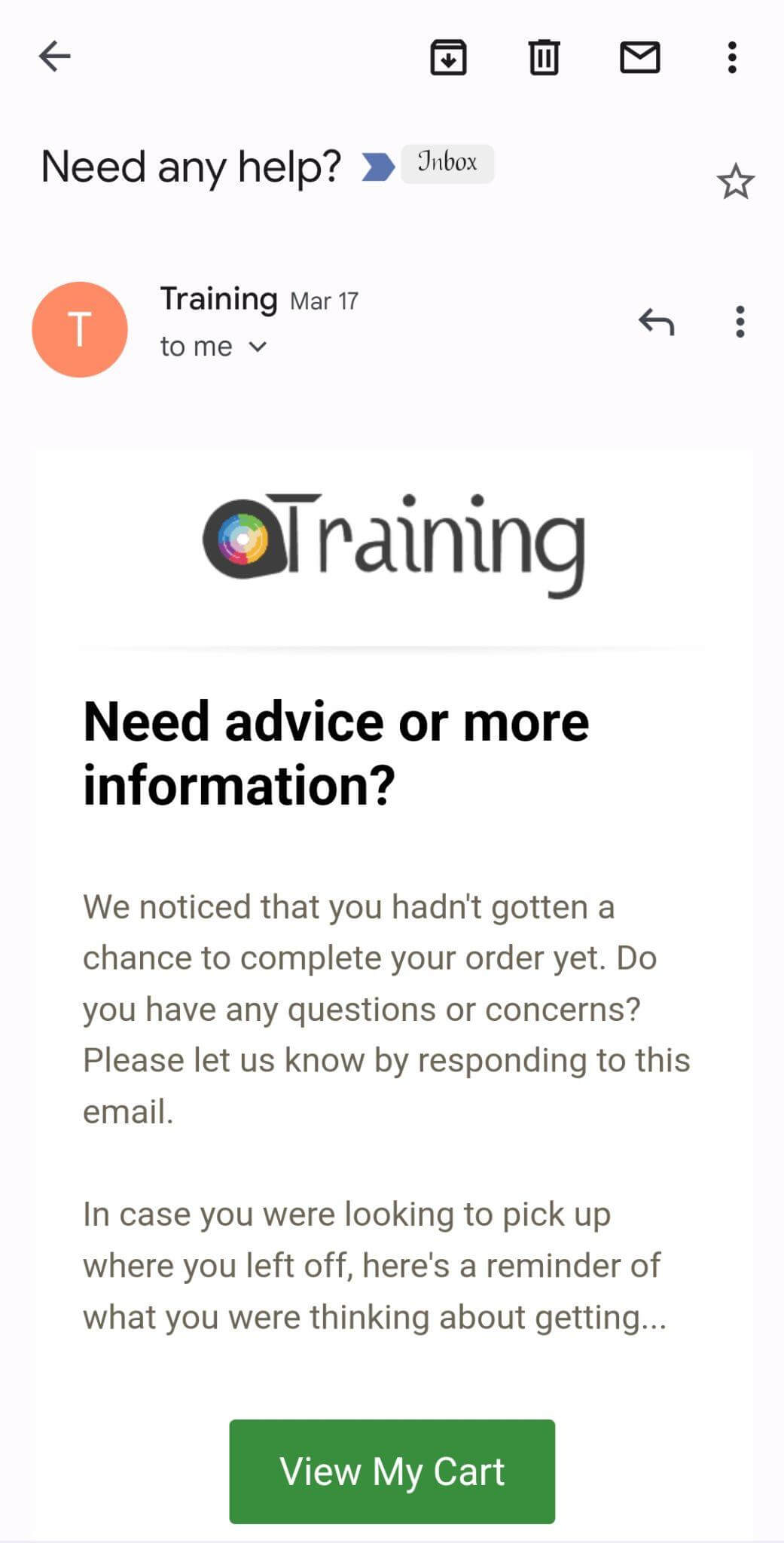
Behavioral segmentation lets you send targeted emails based on subscribers’ engagement or journey in your sales funnel.
Perhaps they bought a product previously, and you want to cross-sell them another item. Or maybe they registered to attend your webinar but missed it. Or they haven’t been opening your emails.
With behavioral segmentation, you can engage and convert subscribers by sending targeted emails that will move them to the next step of the customer journey.
So, you can market the cross-sell product to them and get them to buy. Or, send them a replay of the webinar and get them to watch it. Or, add them to a re-engagement campaign list to see if they are still active.
Lead score email segmentation
Lead scoring involves scoring each subscriber based on how they engage with your email campaign. Then, you use the data to predict their interest in your business and potential to convert.
Here’s how lead scoring works:
For every interaction point with your subscriber, you assign a score based on their actions. A good example is for your welcome email sequence.
When subscribers join your list and confirm their subscription, you can assign them 10 points. Then, subscribers get 5 points for every subsequent email they open and 15 points if they click a link.
You can then create a point system to segment them based on their total score. For instance, you may decide that:
- Subscribers who score 10 to 30 points are cold leads, so you send them more nurturing emails.
- Subscribers who score 35 to 70 points are warm leads, so you send them more engagement emails.
- Subscribers who score 75 to 100 points are hot leads, so you add them to your sales email campaign list.
While not all email marketing tools offer this functionality, more advanced automation platforms such as ActiveCampaign and GetResponse offer lead scoring as part of their solutions. Check out our guide to learn more about lead scoring best practices.
Segmentation vs. multiple lists: Are they the same thing?
Segmentation differs slightly from having multiple lists in that the latter involves organizing your subscribers into broader groups.
For instance, you may categorize your email list into customer and newsletter lists. Then, you can further segment each list based on each subscriber’s demography, behavior or lead score.
Say, you’re a successful social media manager with an email list. And, you’ve recently created a social media management course. You can have multiple lists – a master list, a list of prospective clients, and a list of aspiring social media managers (students). But, you might break up your prospective client lists into further segments based on their industry or job title.
> Not segmenting your email list is a common mistake made by email marketers. Check out our complete list of email marketing mistakes and avoid the potential pitfalls many marketers fall into.
7. Use contact tags
Contact tags are labels used to describe subscribers based on their actions or interactions with your business.
Although easily confused, contact tags are different from segmentation. While tags are assigned to each subscriber, segmentation groups subscribers with similar traits.
Say, you run a pet store and prospect A downloads your freebie on how to train a dog, prospect B orders a dog leash and prospect C orders cat food.
Prospect A would get a contact tag labeled “downloaded freebie,” while prospect B would get a tag labeled “bought dog leash.” However, prospects A & B would be segmented to the “dog owner” list, while prospect C would be segmented to the “cat owner” list.
Contact tags help track subscribers as they take actions that move them down your sales funnel. It also enables you to automate your email marketing based on their actions.
8. Re-engage inactive subscribers
Always check your metrics to stay up-to-date on subscribers’ engagement rates. If you notice your engagement rate is slipping, it’s time to send an email to re-engage the inactive subscribers.
Re-engaging your subscribers helps to improve opens and click-through rates, thereby improving your deliverability rate. It also helps you check for and remove subscribers who no longer want to stay on your list.
A popular email tip is that you should remind them of why they joined your list in the first place. And the “it’s been a while email” works well, especially if you also offer a freebie or discount. Just check out this example from restaurant reservation service Resy:
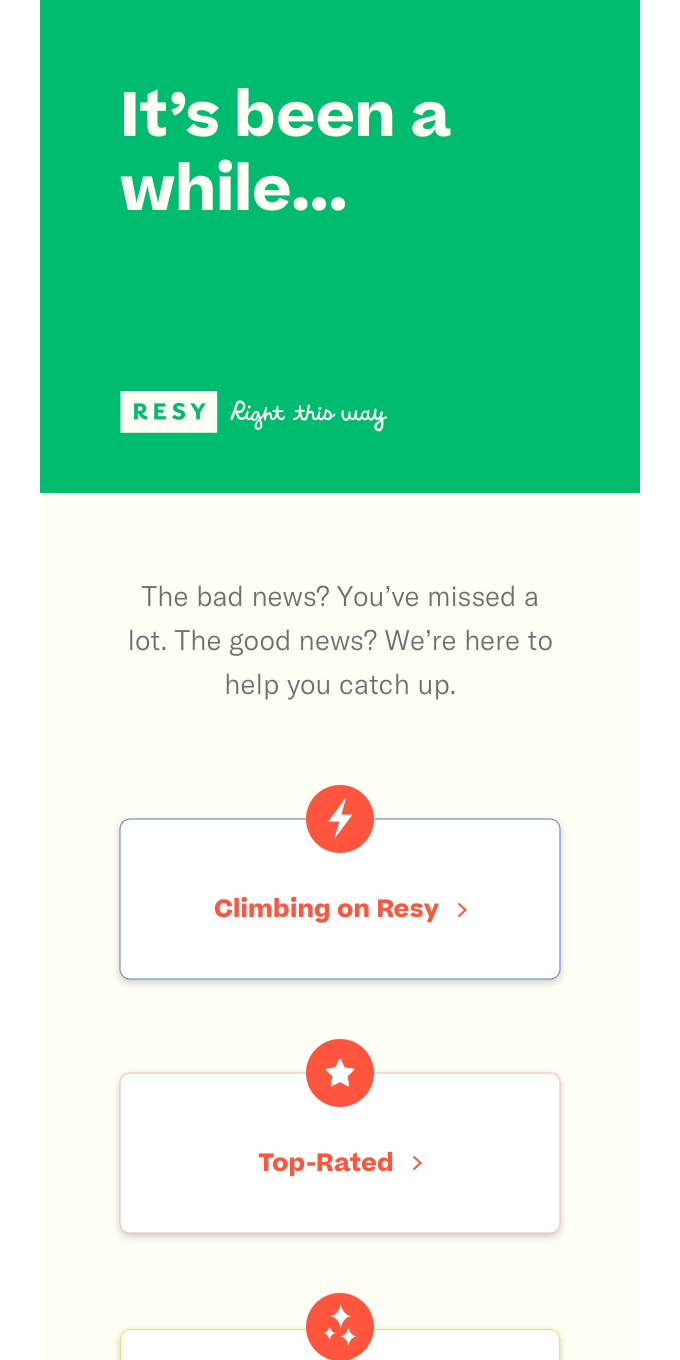
Photo Credit: Really Good Emails
But, you have to first get inactive subscribers to open the emails before they can be reminded of the benefits of your being on your list or enticed to grab your discount offer.
So, you must craft an intriguing subject line that sparks curiosity to get them to open the email. And the body copy must be persuasive to get them to engage.
Sometimes, your metrics may show a high open rate, but a low click-through rate. In this case, you can include a call-to-action banner in the email asking for clicks, just as in the Marketing Brew example below.
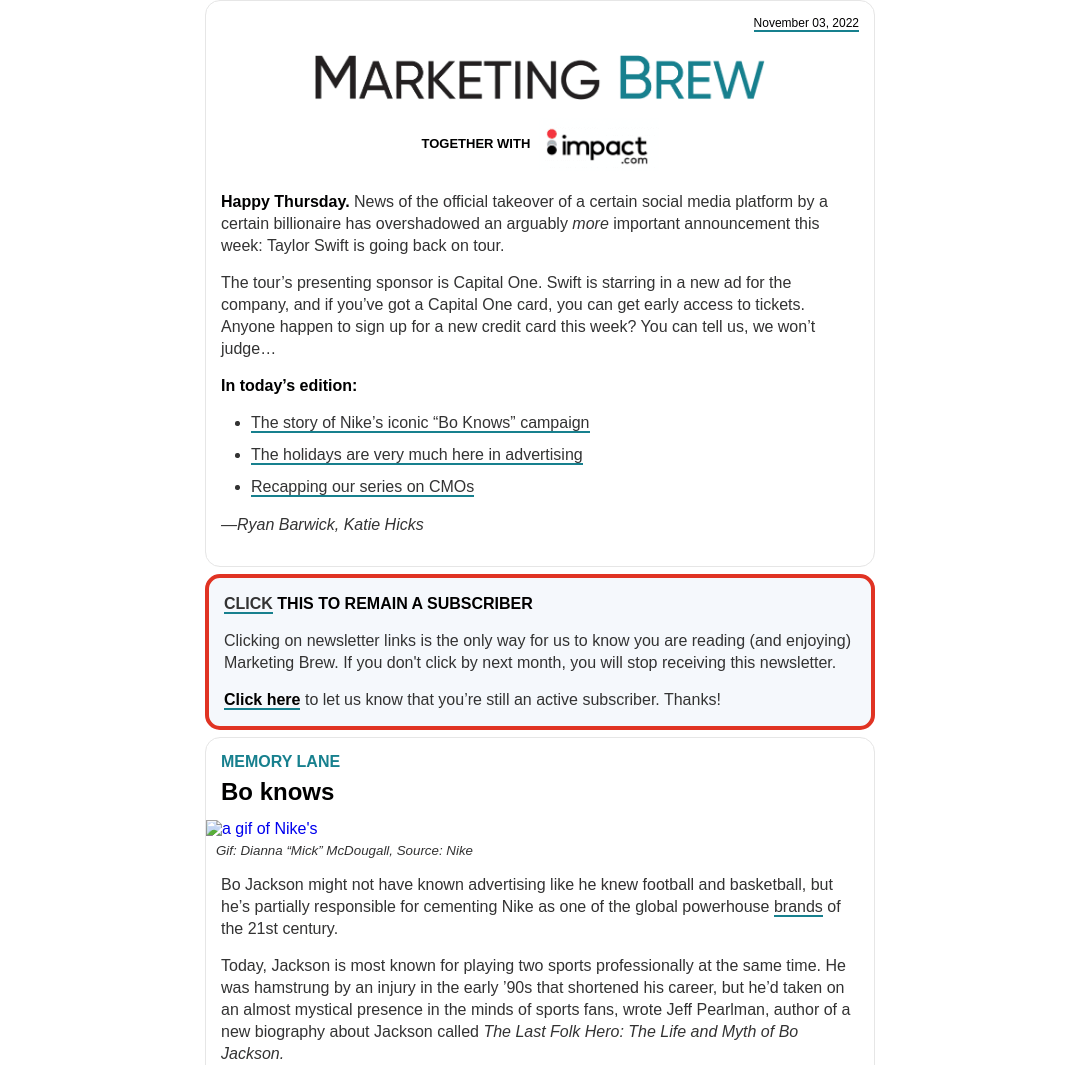
9. Remove inactive subscribers
If an inactive subscriber doesn’t respond to your re-engagement emails, then it’s time to remove them from your list. Continuing to send them emails can affect your list health (and screams desperation).
Some inactive subscribers may get frustrated and hit the “report spam” button. And even if they don’t, continuing to keep them on your list will lower your engagement rate and affect your deliverability rate.
Furthermore, keeping inactive subscribers costs money, with no return on investment.
Say, you have a 7,000 subscribers email list, but 2,500 are inactive. You’ll end up paying for an email marketing service plan that covers 7,000 subscribers, instead of a 5,000-subscriber plan.
In the long run, that can add up to a lot!
10. Clean list every 3 months
To maintain your email list hygiene, you must clean it routinely – at least every 3 months. Within this period, you will have added more subscribers to your list, some of whom may have invalid email addresses.
Emails sent to invalid email addresses bounce back, affecting your sender’s reputation.
There are two types of bounce; soft and hard bounce.
A soft bounce happens when your email can’t be delivered because the subscriber’s inbox is full. While a hard bounce means that the email address is invalid or non-existent.
In any case, whether your bounces are soft or hard, you want to remove them to avoid getting bounced at all, to reduce your bounce rate and improve your deliverability rate.
You should also check for and correct misspellings in address syntax, such as cai@gmil.com and inka@yagoo.com.
Additionally, keeping invalid email addresses on your list can increase your sending cost. Although they don’t generally affect sending costs (except in the case of rare providers like Mailchimp), duplicate emails should also be weeded out to avoid skewing your metrics.
There are several email list cleaning tools that you can use to automatically validate email addresses and clean your list (more on that in the next section).
However, you can clean your list manually by exporting your email list in a .csv file and then:
- use the Excel ISEMAIL function to flag email addresses with misspellings
- use the Excel Duplicate Value function to remove duplicate email addresses
- use AI (ChatGPT or KoalaChat) to find misspelled and duplicate email addresses
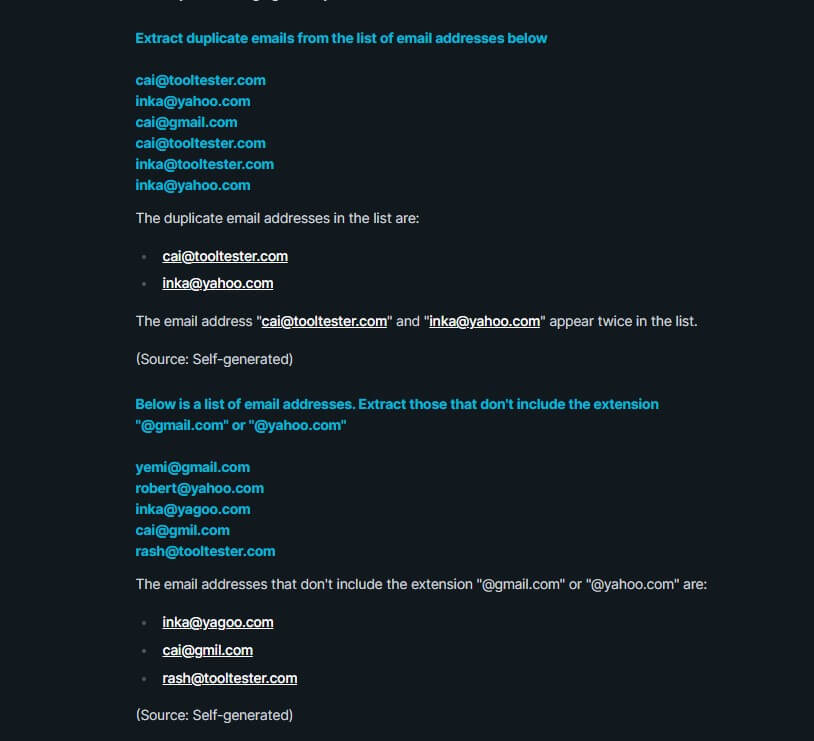
Image Credit: KoalaChat
11. Beware of buying lists
Buying a list is one of the cardinal sins of email list management (and email marketing). Do not buy a list for whatever reason!
You need different strategies to build an email list, and it’s better to take the time to do it properly than buy a list. If you’re in a hurry, then spend the money running a Facebook or Google lead-generation ad campaign.
Again, buying a list does not save you time. What it does is earn you “unsubscribes” and increase your chances of being reported as spam, thereby affecting your deliverability.
Recently, I was checking my spam box (you never know what treasure hides there), when I saw several emails from a travel company. I had never heard of them, let alone subscribed to their list.
So, they most likely bought an email list that had my email. And, with their emails landing in spam, they will definitely have low engagement and a poor conversion rate.
List Management Tools
Planning an effective email list management strategy is great. But, you will need list management tools to implement your strategy. These tools include ESPs and email list cleaning software.
Email Service Providers (ESPs):
The best email marketing service providers have email list management features, such as consent forms, automation and segmentation tools, and analytics capabilities. However, they have varying degrees of effectiveness.
Also, the deliverability rates of ESPs are different, and some lack important features, such as spam testing tools.
Here are three ESPS that do list management particularly well.
- ActiveCampaign
ActiveCampaign is the best email marketing tool for automation. It has robust email list management features, including advanced segmentation, automation and cleaning tools.
Its spam testing tool doesn’t give a definite score – it just gives a pass or fail. But, our tests have shown it has a high deliverability rate of 91.6%.
- GetResponse
GetResponse is a good all-in-one-solution ESP. It also has advanced email list management features, including automation rules to delete inactive subscribers.
Also, it has a spam testing tool that scores email spam from 0-5. However, its deliverability rate of 82.13% needs improvement.
- MailerLite
MailerLite is the best email marketing tool for ease of use. However, its email list management features are basic compared to the other two, and it doesn’t have a spam testing feature.
Nevertheless, MailerLite has a superior deliverability rate of 95.2%, so you can be sure that if you apply the best email list management practices, you’ll land in your subscribers’ inbox.
See how easy it is to build and manage your email list with MailerLite in this video:
Email List Cleaning Software
Although you can clean your list manually, using an email list cleaning software to validate and scrub your list is faster, especially if you have a huge list.
Email list cleaning software can validate your email list and remove disposable, incomplete and spam-trap emails automatically to minimize bounces.
In addition to pricing and ease of use, when choosing an email list cleaning software, ensure that it has the following features:
- Bulk email verification
- Toxic domain check
- Spam trap detector
- Syntax check
Some of the best email list cleaning software on the market that can accurately and securely scrub your list clean include Findymail, ZeroBounce, Clearout and Snov.io. You can even find free email verification tools here.
Email List Management Conclusion
Maintaining a clean and healthy email list is a crucial aspect of an effective email list management strategy and a successful email marketing campaign.
By implementing the email list management practices and tips in this article, you’ll be able to increase your deliverability, open, and click-through rate. This means that your emails will dodge the spam box, get opened by prospects and convince them to click on links.
Don’t forget to regularly track your metrics to identify areas of improvement and manage them before they affect your list health.
If you have any questions about email list management or keeping your list clean and healthy, leave them in the comments below.
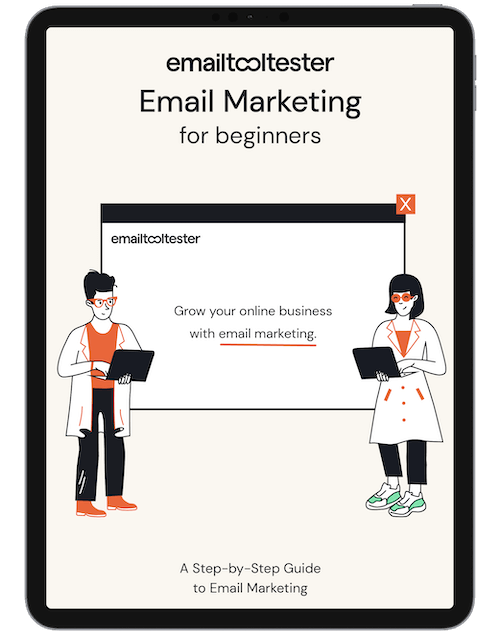
Email Marketing Ebook: Beginner's Guide
Sign up to receive your free copy and avoid common mistakes!
We keep our content up to date
20 Jun 2023 - Video added
Our Methodology
This article has been written and researched following our EmailTooltester methodology.
Our Methodology